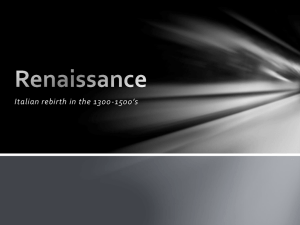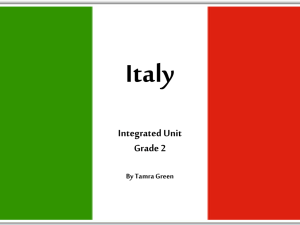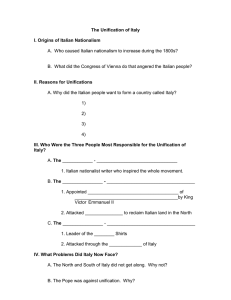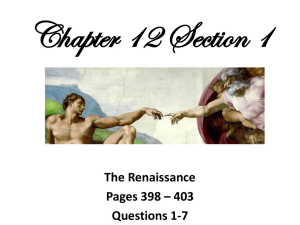2015 Draft Syllabus
advertisement
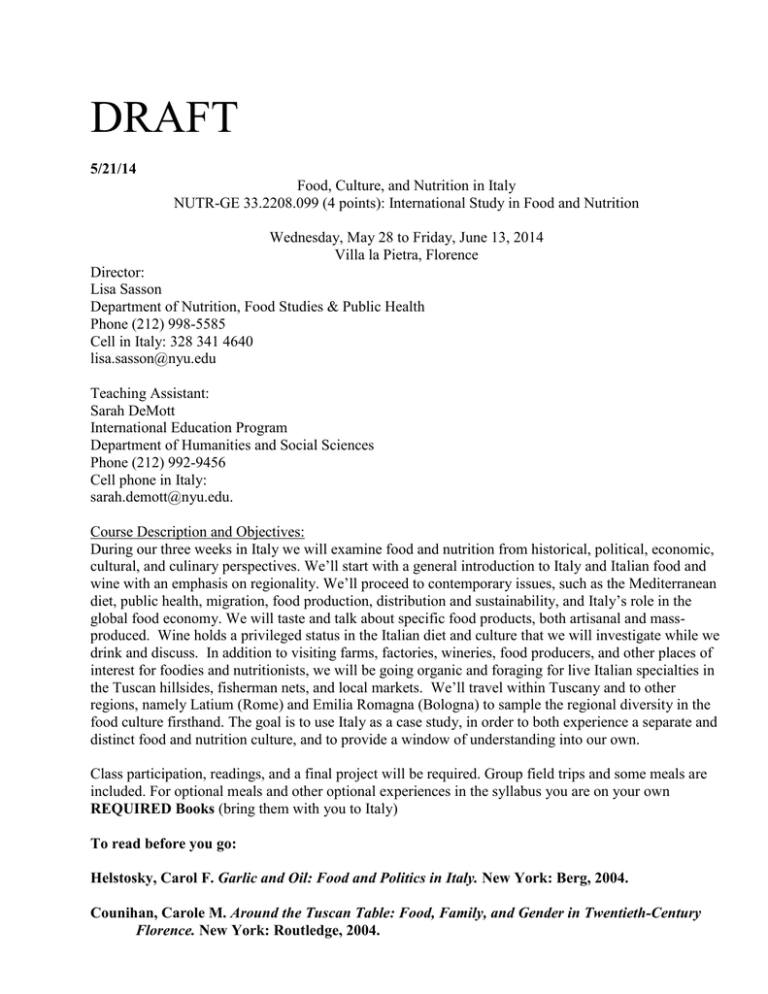
DRAFT 5/21/14 Food, Culture, and Nutrition in Italy NUTR-GE 33.2208.099 (4 points): International Study in Food and Nutrition Wednesday, May 28 to Friday, June 13, 2014 Villa la Pietra, Florence Director: Lisa Sasson Department of Nutrition, Food Studies & Public Health Phone (212) 998-5585 Cell in Italy: 328 341 4640 lisa.sasson@nyu.edu Teaching Assistant: Sarah DeMott International Education Program Department of Humanities and Social Sciences Phone (212) 992-9456 Cell phone in Italy: sarah.demott@nyu.edu. Course Description and Objectives: During our three weeks in Italy we will examine food and nutrition from historical, political, economic, cultural, and culinary perspectives. We’ll start with a general introduction to Italy and Italian food and wine with an emphasis on regionality. We’ll proceed to contemporary issues, such as the Mediterranean diet, public health, migration, food production, distribution and sustainability, and Italy’s role in the global food economy. We will taste and talk about specific food products, both artisanal and massproduced. Wine holds a privileged status in the Italian diet and culture that we will investigate while we drink and discuss. In addition to visiting farms, factories, wineries, food producers, and other places of interest for foodies and nutritionists, we will be going organic and foraging for live Italian specialties in the Tuscan hillsides, fisherman nets, and local markets. We’ll travel within Tuscany and to other regions, namely Latium (Rome) and Emilia Romagna (Bologna) to sample the regional diversity in the food culture firsthand. The goal is to use Italy as a case study, in order to both experience a separate and distinct food and nutrition culture, and to provide a window of understanding into our own. Class participation, readings, and a final project will be required. Group field trips and some meals are included. For optional meals and other optional experiences in the syllabus you are on your own REQUIRED Books (bring them with you to Italy) To read before you go: Helstosky, Carol F. Garlic and Oil: Food and Politics in Italy. New York: Berg, 2004. Counihan, Carole M. Around the Tuscan Table: Food, Family, and Gender in Twentieth-Century Florence. New York: Routledge, 2004. Required for assignments due MAY 27. After reading the required readings, briefly answer both questions below and be prepared to discuss your response at our first class meeting on May 27. (Students responses should be approximately 1 page per questions and should be posted to our NYU Classes site under assignments.) Questions: Garlic and Oil: Italian cuisine has been highly romanticized. How does Carol Helstosky challenge the myths and assumptions about Italian food? Around the Tuscan Table: Carole Counihan illustrates how the historical, cultural, social, and economic role of food has shape the modern portrait of the Italian people. Using three examples that draw from the reading, please explain how food and food production has influenced Italian identity? Required for class preparation in Italy: Most of the required readings are available on NYU Classes- under Resources folde It is essential that you read and bring these readings (or review via internet in computer lab at La Pietra) to Italy. These readings were carefully selected to coordinate with the lectures and field trips. You will have a much better understanding and appreciation of the lectures if you do the readings beforehand. It will also help you with ideas for your research project in Italy. RECOMMENDED MOVIES The Bicycle Thief, directed by Vitorio de Sica (1948) I Vitelloni, directed by Frederico Fellini (1953) RECOMMENDED READINGS on Italy (not necessary to have them in Italy) Barzini, Luigi. The Italians: A Full-Length Portrait Featuring their Manners and Morals. New York: Simon & Schuster, 1996 (1964). Capatti, Alberto and Massimo Montanari. Italian Cuisine: A Cultural History. Trans. Aine O’Healy. New York: Columbia U.P., 2003. Hearder, Harry. Italy: A Short History. New York: Cambridge U.P., 2001. Jones, Tobias. The Dark Heart of Italy: Travels through Time and Space across Italy. London: Faber and Faber, 2003. Leavitt, David. Florence, A Delicate Case. New York: Bloomsbury, 2002. Lewis, Norman. Naples ’44. London: Palace Athene, 2003. Lewis, R.W.B. The City of Florence: Historical Vistas & Personal Sightings. New York: Henry Holt & Co., 1995. Parasecoli, Fabio. Food Culture in Italy. Westport, CT: Greenwood, 2004. Slow Food Editore. A World of Presidia: Food, Culture & Community. White River Jct. , VT: Chelsea Green, 2005. RECOMMENDED BOOKS on Italian Food and Wine (for personal reference) Anderson, Burton. Treasures of the Italian Table: Italy’s Celebrated Foods and the Artisans Who Make Them. New York: William Morrow, 1994. Andrews, Colman. Flavors of the Riviera: Discovering Real Mediterranean Cooking. New York: Bantam, 1996. Artusi, Pellegrino. Science in the Kitchen and the Art of Eating Well. Trans. Murtha Baca. Toronto: U. of Toronto P., 2004. Bastianich, Joseph and David Lynch. Vino Italiano: The Regional Wines of Italy. New York: Clarkson Potter, 2002. David, Elizabeth. Italian Food. London: Penguin, 1989 (1954). Field, Carol. Celebrating Italy. New York: William Morrow, 1990. Gray, Patience. Honey from a Weed: Fasting and Feasting in Tuscany, Catalonia, The Cyclades, and Apulia. New York: Harper & Row, 1987. Jenkins, Nancy Harmon. Flavors of Tuscany: Traditional Recipes from the Tuscan Countryside. New York: Broadway, 1998. Kaspar, Lynne Rosetto. The Splendid Table: Recipes from Emilia-Romagna, the Heartland of Northern Italian Food. New York: William Morrow, 1992. Lanza, Anna Tasca. The Heart of Sicily: Recipes and Reminiscences of Regaleali, A Country Estate. Woodbury, CT: Ici La Press, 1993. Negrin, Micol. Rustico: Regional Italian Country Cooking. New York: Clarkson Potter, 2002. Plotkin, Fred. La Terra Fortunata: The Splendid Food and Wine of Friuli-Venezia Giulia. New York: Broadway, 2001. Roden, Claudia. The Food of Italy, Region by Region. London: Vintage, 1999 (1989). Root, Waverley. The Food of Italy. New York: Vintage, 1992 (1971). Tornabene Wanda and Giovanna, with Carolyn Carreño. 100 Ways To Be Pasta: Perfect Pasta Recips from Gangivecchio (Sicily). New York: Knopf, 2005. de Vita, Oretta Zanini. The Food of Rome and Lazio: History, Folklore, and Recipes. Trans. Maureen B. Fant. Rome: Alphabyte di Maureen Brown, 1994. CLASS SCHEDULE Wednesday, May 28 Arrival Day Check into Villa Natalia 6:00 p.m. Gather on terrace of Villa Natalia to walk to dinner (about 30 min.) Wear good walking shoes! 7:30 p.m. Welcome dinner of traditional Tuscan specialties at Osteria Pepo, Via Rosina 6r. Thursday, May 29 Introductions and Welcome Reception 10:00 -12:00 p.m.: Overview of Course Content, Outline, Grading, and Expectations Discuss projects and conference. Divide students into two groups. Explain dinner series with guest lecturers 12:00 – 1:30 p.m.: Introduction to Nutrition & Mediterranean Diet Lecture by Lisa Sasson 1:30 -3:00p.m.: Break for lunch and orientation 3:00-5:00 p.m. Student registration and Orientation to dorms and student life, Meet at Villa Natalia – Blue Room 6:30 p.m. Welcome Dinner at La Pietra Meet and Greet with La Pietra Summer Program Students Friday, May 30 Garden Tour and Italian Nutrition: Brain, Nutritional Counseling 10:00 a.m.: Tour: Villa La Pietra: House and Garden Tours divided by groups (I and II) led by La Pietra staff and docent of the Acton art collection. Meet outside the main entrance to La Pietra (the house) 11:30-12:30 p.m.: Lesson and Meet Villa Ulivi Discussion of Research Projects and Techniques for Field Research Lecture with Lisa Sasson and Sarah DeMott 12:30-2:00 p.m.: Lunch 2:00- 3:00 p.m.: Food and the Brain: the regulatory mechanisms controlling appetite, hunger and satiety Lecture by Domenico Pellegrini, MD/Pharmacologist, University of Florence 3:00-4:00 p.m.: The Mediterranean Diet Today; Nutrition Counseling from the Perspective of an Italian Nutritionist Lecture by Lucia Bacciottini 8:00 p.m. Cooking Flavors of Tuscany at Lisa’s Apartment A dinner party at Lisa’s apartment. Students interested in cooking will meet at Lisa’s apartment to cook dinner for class- Dinner at 8:00 p.m. Saturday,May 31 From Picnic to Pietra 9:00 a.m.: Market Tour Group I & II meet on Via dei Macci (outside Caffe Cibreo) – great place for coffee but if you sit in or outside café be prepared to pay more! 9:30-11:00 p.m.: Market Tour of San’t Ambrogio Market – purchase your surprise picnic ingredient 12:30- 1:45 p.m.: Market Picnic Lunch Table outside Villa Ulivi - Discuss market experience 3:00 – 4:00 p.m.: Erica Moretti, Lecture on Italian Family Food Culture 4:00-5:00 p.m.: Erica Moretti, Around the Tuscan Table Sunday, June 1 Free Day to work on your project Submission Deadline of project proposal-post on NYU Classes: Your project title Project abstract (few sentences) 3 examples of how you plan to do your observational research Monday, June 2: National Italian Holiday Radicondoli, Tuscan Hilltop Town Sustainable Farm Visit and Tuscan Cooking Lesson *Wear walking shoes for farm and forest. 8:30: Meet at the Bus 8:30-9:30 a.m.: Bus Ride from Florence to Radicondoli 9:30 am: Tour of the Gardens and Property Discussion about Sustainable Farming Gather veggies, greens and eggs for our lunch 11:00: Cooking Class for Lunch Making: Pasta, Torta di Verdura ( Vegetable Pie) and Cantucci ( biscotti) 1:00 - 3:00: Lunch 3:00- 4:00 Discussion of Agriturismo, this form of farm tourism in Tuscany 4:00-5:00: Go for a Country Walk & Stretch Out After Lunch 5:30- 7:00: Free Time in Village of Radicondoli- Tuscan Hilltop Town 7:00: Return to Florence Tuesday, June 3: History of Italian Food, Wine, Olive Oil Marketing of Chianti Wine 9:30 a.m. An Introduction to Italian Wine and Olive Oil Lecture and Tasting of wines and Olive Oil by Fillipo Mangini, Wine Specialist and Journalist 1:00 -3:00: Lunch Break 3-4:00 p.m.: History of Italian Food and Food Culture Lecture by Fabio Parasecoli, Food Historian 4:30- 5:30 p.m. The Business Aspect of Wine: Marketing Strategies and Importing and Exporting of Wine Lecture by Diletta Frescobaldi Wednesday, June 4: Field Trip to Wine Country – Greve and Chianti (Verrazzano Winery) *Wear comfortable walking shoes. 8:30 a.m.: Bus departure from outside Villa Natalia9:30 - 10a.m.: Free time in the main square of Greve in Chianti (a Slow City). Don’t miss the historic Falorni butcher shop. 11:00 a.m.: Verrazzano Winery Tour of the winery and tasting led by Gino Rosi followed by lunch of local specialties. Winery Lunch at Verrazzano 2:00 p.m.: Possible Walking Tour in Tuscany Thursday, June 5: Visit to Public School and Large Scale Food Producer Tour of Public School Food Program and SIAF at Bagno a Ripoli- large scale food producer of prepared foods. They follow principles of 0 KM and Slow Food. They prepare meals for hospitals and schools. 8:00 a.m.: Bus 9:00-11:30 a.m.: Signora Bucelli - Town Nutritionist Tour a School Cafeteria and Speak with Staff Visit a School Cafeteria, classroom and tour school garden 12:00 p.m.: Tour SIAF Facility 1:00 p.m.: Lunch at SIAF with the Mayor 2:30 p.m.: Talk led by the director of SIAF, Antonio Ciampi 4:00 p.m.: Return to La Pietra 6:30 p.m.: Valentina's Farm Dinner – TBA Friday, June 6 Research Day for Field Work Free day to work on research projects Saturday, June 7 Travel to Rome 7:45 a.m.: Meet at Florence Train Station (S. Maria Novella) to Rome 8:14 am: Train # 9505 to Rome 10:00 a.m.: Arrive in Rome (Roma Termini Station) 10:30 a.m.: Check into Hotel Diana Via Principe Amedeo, 4 00185 Roma Phone: +39.06.478681 11:30 a.m.: Afternoon and evening free 7:30 p.m.: Aperitivo at sunset at Maureen Fant’s roof top terrace (overlooks The Coliseum) Address: via dei SS. Quattro 42 Sunday, June 8 Cuisine and Wine of Ancient and Contemporary Rome Gusto Lab Institute at Via Giulia, 130 9:45 a.m.: Meet outside Gusto Lab 10.00 a.m.: Food in Ancient Rome: Archaeology and Gastronomy and Contemporary Roman Cuisine Lecture by Maureen Fant, Roman Food Expert, Archaeologist, and Historian 11:15 a.m.: Carbohydrates, Obesity, and Italian Food Culture Lecture by Vincenzo Bacci MD, Endocrinologist 12:15- 1:45 p.m.: Lunch- on your own 2:00-4:30 p.m.: Gelato Production, Food Specialties of Rome Production of gelato - lesson with machinery Visit 2 gelato shops (organic - historical) Meeting with the owner and marketing manager 4:30 p.m.: On Your Own to Explore Rome Monday, June 9 Pulgia/ Southern Italy and the Mediterranean Diet *Pulgia is an Italian geographical region. It is on the east coast of southern Italy. *Altamura, is a city known for its particular quality of bread called Pane di Altamura, which is sold in numerous other Italian cities. 6:45 a.m.: Meeting for Departure 7:00 a.m.: Bus Departs for Pulgia 12:30 – 2:00 p.m.: Altamura – Visit Panificio (Bakery) – tastings at bakery – D.O.P./Slow Food 2:00 – 4:00 p.m.: Wine Production visit and tasting 6:00 p.m.: Arrive in Taranto ( beautiful seaside town in Puglia) - check in Hotel 6:30- 10:30 p.m.: Boat Tour & Mussel Harvesting with Biologists followed by dinner Tuesday, June 10 Ostuni is an enchanted white city and the jewel of Pulgia 8:00 a.m.: Breakfast and checkout 9:00-10:00 a.m.: Meeting with Cibus and Culture Nutrition Association- a discussion on “Obesity Southern Italy” 10:15-11:30 a.m.: Extra Virgin Olive Oil Visit and Tasting 11:30 – 1:30 p.m.: Arrival in Ostuni, Small Seaside Village 12:00 – 1:30 p.m.: Free Time & Lunch On Your Own in the City 2:00-4:00 p.m.: Free Time & Lunch On Your Own on the Beach 5:00 p.m.: Check in Hotel Masseria 5:30 p.m.: Cooking Class Making Orecchietta Pasta & Dinner Wednesday, June 11 Pulgia/Florence 8:30 a.m.: Breakfast and Check Out from Hotel 9:30 a.m.: Masseria Organic Farm Specializing in Tomato and Eggplant Cultivation 11:30 p.m.: Bus Departure Back to Florence Lunch Stop at AutoGrill 11:00 p.m.: Estimated Arrival in Florence Thursday, June 12 2:00 p.m.: La Pietra Student Conference on the Mediterranean Diet Possibly in conference room in Villa Sassetti Presentations by NYU Student in Program- details below 7:30 p.m.: (optional): Farewell dinner Friday, June 13 Departure Check-out from La Pietra by 12 Noon THE OBSERVATION/RESEARCH PROJECT Our goal, while you are in Italy, is to expose you to as many different aspects of Italian food and nutrition culture as three week’s time will allow. It is our hope that at the end, you will not only gain insight into Italian culture, but that your experiences will also give you new insights into your culture back home in the U.S. While the philosophy behind our syllabus is generalist in nature, we do want each of you to become a specialist in at least one aspect of food and/or nutrition culture. There isn’t much point to being in Italy and being stuck in front of a computer or with your head buried in a book. You have to get out there and experience and observe a different culture in order to really understand anything about it. To this end we have created a project that includes an observation/research component in Italy, and a similar component and paper back in the U.S. On the first day of classes (5/29) you will be asked to choose a food- or nutrition-related topic that will draw on your personal and scholarly interests. The options for topics are unlimited, but they should adhere to the following parameters: 1. 2. 3. 4. 5. The topic you choose must be a bona fide topic of cultural interest that pertains to food or nutrition and that has been studied or written about to some extent. The topic should be approachable both from an Italian and an American perspective, i.e., you will have to find evidence/data and information in both countries. The topic should contain a historical or at least a temporal element, i.e., there should be some way to trace changes over time. There should also be an experiential component, which will not only help keep your interests focused, but will also make your writing more engaging. The topic should allow for some creative conceptualization and interpretation to give your finished project some color and interest. You should have a good idea about what you want to study before you get to Italy. And you should do some preliminary research before you get there so you don’t have to waste any time floundering about. Here are some suggestions for topics: Coffeehouse culture Emigrant Food Patterns Food Biotechnology Food Advertising to Children Representation of women’s bodies in food advertisements Tableware/table settings What makes a meal in Italy? Mealtimes/meal patterns/snacking Restaurant decorum Vegetarianism Functional foods in the marketplace Health claims and product labeling Vegetables, Italian-style Home meal replacement Convenience foods Roadside food The culture of professional cooking The larder Service and servitude “Family meal” in the restaurant setting Fats Cultural representations of food’s relationship to disease Food as a metaphor for the Italian lifestyle Slow Food Movement Sustainable Eating, Food and the Environment Food portrayal in film and other pop culture Italian attitudes about food Supplements Sustainability in farming, food production, etc Obesity: Is it an issue? Wine culture Wine Tourism Wine and alcoholism Over the course of three weeks you should observe and investigate various angles of your topic, keeping a notebook of observations and insights. (Taking photographs will also help.) Be creative. Hang out in coffee shops, flip through magazines, take photos of billboards, walk through grocery stores, watch t.v. with the sound off, look at paintings and look at people looking at paintings, talk to fellow students about their experiences, etc. Upon your return to the United States, you should carry out a similar observational exercise on the same topic. Look for similarities and differences between the two countries in cultural representations. Make notes and take pictures again to jog your memory when you go to write up your paper. (You will have to turn in your notebooks, photographs, etc., along with your paper.) The final paper should compare and contrast your observations in Italy and the United States. It should include some sort of sociocultural discussion of what might account for the differences and similarities. The best papers will weave description, history, and theory into a tight, creative, and informative representation of this important cultural aspect of food and/or nutrition. Remember that the goal here is to produce a paper that could only have been written after having done on-the-ground research in Italy, keeping in mind that the paper has to be clear enough so that someone who didn’t go to Italy will understand your main points. You need to use peer reviewed journals, books, to support your research. All your sources should be documented in the paper. La Pietra Student Conference on the Mediterranean Diet On our last day at La Pietra we will be hosting a mini conference on the Mediterranean Diet based on your projects. Students will be divided into panels of 4 or 5 presentations, according to common themes. A moderator and two discussants will be chosen for each panel. (The assignments and schedule will be compiled and distributed by June 8th. Moderators will introduce the topic of the panel and the speakers, and will also be responsible for keeping time. Speakers will have 5 minutes to present their research findings in Italy. (A computer and projector will be available for those who need it). Timing will be kept very strictly (so rehearse your presentation in advance). After all of the presentations on the panel are finished, each discussant will have 5 minutes to comment on the presentations and propose questions for discussion. 10 minutes of Q&A discussion will follow the presentation of discussants. Conference presentations and participation will count for 20 percent of your grade on the final project (see details below). Organization of the Final Project Clear organization will help you complete the assignment. To help you structure the paper, here are some guidelines:- an estimate of length of paper is about 12 pages ( not including photos, reference page etc) Title: Pick a good, strong title that conveys your topic and your perspective on it. Introduction: Explain why you picked the topic and its significance for understanding Italian food and/or nutrition culture. (1-2 pages) Methods: Here’s where you explain what you did to investigate the topic. Explain the places you went, the people you talked to, why you picked these places or people, etc. (1-2 pages) Observations: Report on what you found in an interesting and organized way. Use subtitles and question to define specific areas of discussion, if necessary. Discussion: Here’s where you discuss the comparison—explore similarities and differences between what you observed in Italy and the U.S. What is their significance? Use research to help understand and explain the comparison. Conclusion: Summarize the main point of your paper. You might want to talk about the limitations of your investigations or implications for future research. References: List what seems relevant, and provide citations for any direct quotations from literature or research. Follow the university’s guidelines on plagiarism. Any evidence of plagiarism will result in a failing grade for the course. Include any books, and the peer reviewed journal sources used in your paper Attachments: Use tables, figures, photos, pamphlets, or anything else that pertains. Journals, notes, and/or other raw data that relate to the project should also be included, but please do not send large binders, photo albums, or other heavy objects that will be difficult to return—they will not be returned! Due date: The completed project is by due on August 16, 2013. Late Papers will have points deducted. Please discuss with Lisa Sasson if you have an emergency and must have an extension. You will send an electronic copy of your paper (without the supporting documents- notes, etc) to: lisa.sasson@nyu.edu and sarah.demott@nyu.edu And also a hard copy with all your supporting documents should be handed in to the department or mailed to: NYU Department of Nutrition, Food Studies and Public Health 411 Lafayette Street 5th floor New York NY 10003 Attn: Lisa Sasson Papers and supporting documents can be picked up from the department. Grading of the Final Project Presentation in Conference Observation research (in Italy & U.S.) Final written paper 20% 30% 50 % COURSE GRADING AND STUDENT RESPONSIBILITIES Attendance and Punctuality: You are required to attend all scheduled lectures, cooking classes, and field trips as indicated on the syllabus. If you are ill or cannot make a scheduled event, you should notify us beforehand. We have scheduled many early morning trips and other meetings that require timely departure in order to make our appointments on time. As many people are granting us special access or custom tours, we don’t want to be late, and we won’t be able to hold up the group for stragglers. Please be ready to leave, with everything you need, by the departure time specified in the syllabus. Participation and Preparedness: 25% You are expected to read all the assigned readings before class and actively participate in lectures and discussions. The more prepared you are for the lectures and events the more you will get out of this experience. Many of the lecturers coming to speak to our group don’t regularly participate in these sorts of programs with foreign students. This is a rare opportunity to bring up topics related to your projects, ask questions, or otherwise plumb an impressive array of esteemed experts from different fields. It is not only good for your own edification to engage them directly; it demonstrates respect and appreciation for their time. Behavior Act responsibly and be respectful of your classmates, employees at La Pietra, our lecturers, and invited guests. Although this is not part of your grade, it is expected that you behavior be professional and appropriate 100% of the time. As cliché as it sounds, we are not only representing ourselves, but also our department, our university, our city, and our country. Attire As they say, “when in Rome, do as the Romans do.” Italians dress stylishly but much less casually than Americans, i.e. no revealing tops, no bare midriffs, no very short shorts or skirts. Also note that in many churches your arms and legs must be covered. And here’s a hot Prada tip that will help you not be mistaken for a tourist: Italians loathe flip flops—they consider them disrespectful anyplace that isn’t near a beach. Research Project: 75% A detailed description of the project is provided above.

